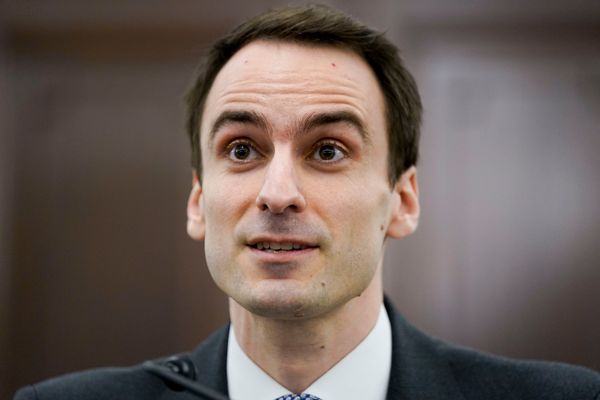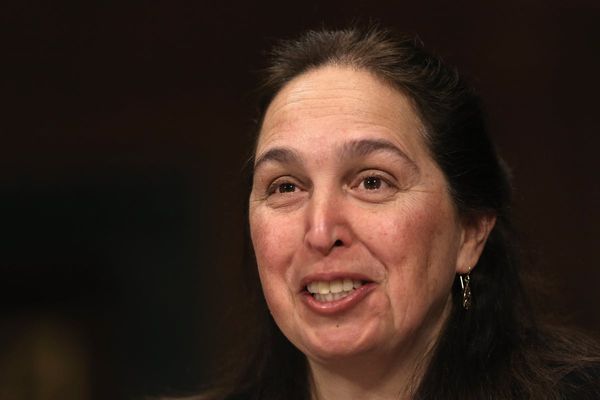Midterm elections typically favor the party that doesn’t hold the White House. Nevertheless, if 2026 is to be a strong year for Senate Democrats, their path to retaking the majority requires them to make gains in states that have swung decidedly Republican in recent years.
Democrats would need a net pickup of four seats to win control of the chamber next year, but only a handful of the anticipated 22 Republican seats on the 2026 map are in competitive states.
New York Sen. Kirsten Gillibrand, who was named chair of the Democratic Senatorial Campaign Committee on Monday, talked up her party’s chances.
“I am confident that we will protect our Democratic seats, mount strong challenges in our battleground races, and look to expand our efforts into some unexpected states,” she said in a statement.
Maine Sen. Susan Collins, who has said she intends to seek a sixth term, is the only Republican running in a state won by Vice President Kamala Harris. But Collins has long proved a difficult target for Democrats. North Carolina Sen. Thom Tillis is another likely Democratic target, although Trump won his state by 3 points.
Republicans are likely to try to grow their majority in competitive states such as Michigan and Georgia — both carried by Trump and where Democrats Gary Peters and Jon Ossoff are respectively up for reelection.
“What we’re going to do is defend the seats that we have and expand the map so that we can increase the majority brought to us by the Trump victory,” National Republican Senatorial Committee Chair Tim Scott of South Carolina told Fox News last fall.
For some Republican senators, though, the biggest worry could be intraparty challengers, with several Trump allies arguing that those insufficiently supportive of the incoming president’s agenda, including his Cabinet picks, should be primaried.
Here’s an early look at senators who could face competitive primary or general elections — or both — in two years time.
Democrats on defense
One of the GOP’s top targets will likely be Ossoff, a Georgia Democrat seeking his second term in a state Trump carried by 2 points last fall.
Peters, who led the DSCC for the previous two cycles, also faces a potential battle in Michigan, a state that backed Trump by a point in November, four years after he lost it to Joe Biden. Democrat Elissa Slotkin, however, was elected to the Senate on the same ballot as the president-elect.
Democrats will also be defending seats in a handful of states that could be competitive under the right circumstances, such as a Republican nominee with widespread appeal or a political environment that strongly favors the majority party.
Chief among those states is New Hampshire, where Democratic Sen. Jeanne Shaheen is up for a fourth term, although she hasn’t said if she’s seeking reelection. The state elected Republican former Sen. Kelly Ayotte as governor in November but has had an all-Democratic congressional delegation since Ayotte lost her seat in 2016. Former Massachusetts Sen. Scott Brown, who moved north and lost a 2014 race to Shaheen, recently said he would consider running.
In Massachusetts, the state’s popular former governor, Republican Charlie Baker, has been mentioned as a potential challenger to Democratic Sen. Edward J. Markey. Baker is currently the head of the NCAA and a spokesman for the organization dismissed the rumors, saying Baker is “not running for any political office.”
Sens. Mark Warner of Virginia, Tina Smith of Minnesota, Ben Ray Luján of New Mexico and Cory Booker of New Jersey — Democrats from states where Trump kept his losing margins to single digits — could also be targets for Republicans, though the incumbents would start off as the strong favorites.
The thin red line
Even before the new Congress was sworn in, Trump and his allies were lobbing threats to back primary challengers to Republican senators they viewed as less than supportive of the president-elect’s announced nominees for administration posts.
GOP senators who oppose his Cabinet nominees ought to face a primary “if they’re unreasonable,” Trump said at a news conference at Mar-a-Lago last month.
Still, ousting incumbent senators in primary elections has been a difficult task for challengers in recent years, happening most recently in 2017. And intraparty tensions could cool off as Republicans begin their efforts to enact Trump’s agenda this year.
Sen. Mike Rounds’ praise of outgoing FBI Director Christopher Wray netted the South Dakota Republican a warning from Charlie Kirk, an influential pro-Trump activist: “Don’t be surprised, Mike Rounds, when you get a primary challenge.”
Iowa Sen. Joni Ernst also drew the wrath of Kirk and other conservative activists when she raised questions about past sexual assault allegations against Pete Hegseth, Trump’s choice to lead the Defense Department. Ernst has muted her criticism after meeting with Hegseth, who has denied the allegations.
Texas Sen. John Cornyn could face several challengers from the right should he run for a fifth term next year, including from state Attorney General Ken Paxton, a staunch Trump ally.
One GOP senator has already drawn a 2026 primary challenger. Louisiana Treasurer John Fleming, a former congressman, launched a bid last month against Sen. Bill Cassidy. In his campaign announcement, Fleming alluded to Cassidy’s 2021 vote to convict Trump at his second impeachment trial, saying that “those who turned their backs on [Trump] and America First were not committed to his fight to make America great again.”
Republicans at risk
Collins and Tillis could also be vulnerable to primary challenges from more conservative Republicans, with Tillis, in particular, saying that he expects one. But both will face competitive general election contests if they get through as expected.
Democrats could make a play for the Ohio and Florida seats that will be on the ballot next year, thanks to the upcoming respective resignations of Republicans JD Vance, the vice president-elect, and Marco Rubio, who is poised to win speedy confirmation as Trump’s secretary of state. Cornyn’s seat could also be a Democratic target in a state that has long proved elusive to the party, as could Alaska, where Sen. Dan Sullivan is up for a third term.
Retirement watch
The 2026 Senate map could also be shaped by retirements. Sen. Richard J. Durbin of Illinois, who turned 80 in November and is the second-ranked Democrat in the chamber, has filed paperwork for reelection but has not formally announced that he is running. Durbin is in his fifth decade in Congress, having first been elected to the House in 1982 and then the Senate in 1996.
On the Republican side, Sens. Mitch McConnell of Kentucky, 82, and Jim Risch of Idaho, 81, also haven’t publicly disclosed their plans. McConnell, who stepped down as Senate GOP leader this Congress, is currently in his seventh term and has experienced a few health issues in recent years. Risch, who was first elected senator in 2008, has been in elective office since the Nixon administration.
And Rounds has been mentioned as a potential candidate for South Dakota governor, an office he previously held for two terms. Another GOP senator, Tennessee’s Marsha Blackburn, has not ruled out a gubernatorial bid, though having just won a second Senate term in November, she won’t have to give up her seat to run.
The post An early look at potentially vulnerable senators in 2026 appeared first on Roll Call.







